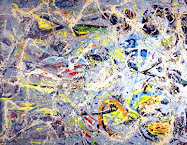
I have become Rothko-ized! Now, I am a fully functioning zombie in the Mark-Mode.
Just kidding. I will be "out of pocket", as the hip people say, for the next three weeks. On the road for Bellevue, Park City and Sun Valley. Reports will be posted at
the
Endless Summer Art Fair.
You are owed a better end to the Rothko study. Sorry, I'm not ready for the definitive post, yet. I will have some down time between driving stretches, and maybe I'll get to post a little.
The quick things I can share are my pre-conclusions. Greenberg and that whole gang (including MR) were so impressed with abstraction being the break-out style for modern art that they felt they needed to push it to it's absolute limits. I'm not sure if we have reached those limits, yet. The cracks in that infrastructure developed before the Abstract Expressionist school could run its course.
I disagree with the dialectic that insists abstraction is the end-game of art. There are some solid values to abstraction, and it is fundamental to art as a historic continuum, and as a rudimentary part of the formal structure of art itself. I love the stuff, personally.
Rothko was a huge figure on the American landscape, whose color field art did a better job of breaking away from figuration than Pollock's art, IMHO. Not to compare too much, but the lack of line and the forwarding of the element of color are why I say MR is better. Action painting, as absolutely fantastic as it is, is still very dependent (Pollock's work) on the line.
Let's see. Now that I've dug this big hole, I guess I'll have a fine job ahead of me to fill in the rationales! I don't want to leave you with a comparison between JP and MR. That's too far off the mark for understanding the Abstract Expressionists.
Let's leave you with this awesome photo of
The Irascibles, a group of artists otherwise known as the Abstract Expressionists, or the New York School. I wanted to photoshop myself in there as an interviewer, but I didn't want a lawsuit from the photographer. Perhaps you'll just have to imagine that part.
Image of the Abstract Expressionists known as The Irascibles.
http://www.artlex.com/ArtLex/a/images/abstexp_irascibles_lg.jpeg"The Irascibles" (photo by Nina Leen, 1950, for
Life magazine)
Front row, left to right: Theodore Stamos, Jimmy Ernst (son of Max Ernst), Barnett Newman, James Brooks, Mark Rothko.
Middle row: Richard Pousette-Dart, William Baziotes, Jackson Pollock, Clyfford Still, Robert Motherwell, Bradley Walker Tomlin.
Back row: Willem De Kooning, Adolph Gottlieb, Ad Reinhardt, and Hedda Sterne.
Note:
Want to know more about Hedda
Sterne?
Fascinating. She is the last surviving member of this famous photo.








































